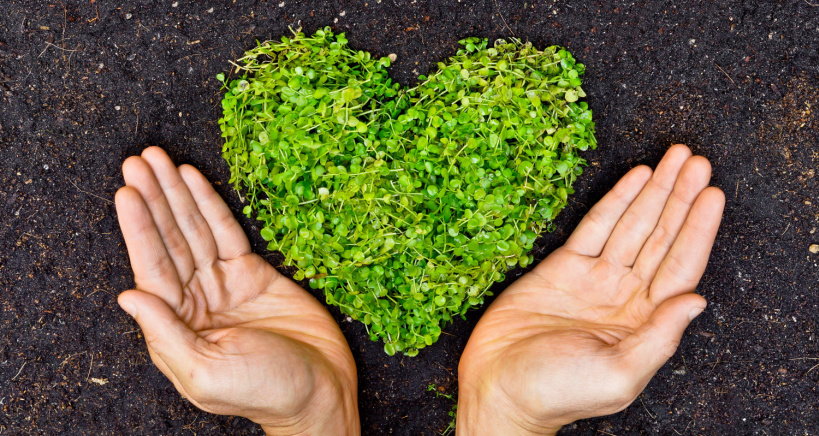
Did you know that by simply cutting your meat consumption in half, you can save approximately two trees per year? By carrying a reusable spork with you to school or work, you could save nearly 500 single use plastic utensils from the landfill per year. And that’s nothing compared to how much plastic waste you can prevent by using only reusable dishes in your home kitchen.
Those who love to cook (and to eat) have so many reasons to be grateful to Mother Earth. Our vegetables, fruits, grains, and even meat depends on air, water, and dirt. Unfortunately, producing these items has become a major driver of climate change, pollution, and deforestation. The Amazon and other forests are under threat due to land being cleared for agriculture or to pasture animals. Single use plastics, that don’t degrade in landfills, end up in the ocean. And, unfortunately, a lot of edible food ends up rotting away in landfills as well.
Isn’t it time to show some love and appreciation to the planet that provides so much for our kitchens, by turning them into Earth-friendly zones? The good news is that setting up a green, eco-friendly kitchen doesn’t take too much cost or effort. Switching out a few habits and experimenting with new ingredients can benefit the planet, and provide new, exciting, green culinary opportunities.
The Meat Dilemma — and Some Solutions
Environmentalists and nutritionists alike have been pushing plant-based diets recently. Not only may vegetables, beans, fruits, and grains be healthier than meat, the actual production of meat is a big trigger for numerous environmental issues. To raise a cow from birth to plate, farmers need:
- Grazing space: Clearing land to raise cattle is a major contributor to deforestation.
- Cattle feed: Forests are cleared not just to raise livestock, but to grow the plants that will feed them. For example, it takes about seven pounds of animal feed to produce two pounds of chicken feed.
- Emissions: A byproduct of car usage is carbon emissions released into the air. Likewise, a byproduct of raising cattle is methane emissions released into the air. A single cow produces around 220 pounds of methane per year!
Tips on Reducing Meat Usage in the Home
For home cooks who want a green kitchen but enjoy meat, there’s no need to cut the meat out of your life altogether. Here are some ways to enjoy meat, but still reduce its environmental harm:
- Eat meat, but eat less of it. Consider having one vegetarian or vegan night a week. This gives you a chance to try out non-meat dinner options.
- Remember, flavor is your friend. If your dish is loaded with spices and sauces and packed with flavor, your guests won’t even be able to tell whether the base for it is ground beef or a vegetarian substitute.
- Serve it with sides. Serve your meat dishes alongside more eco-friendly side dishes for your guests to fill up on. This makes your meat go a longer way, and no guest has ever complained about being served a greater variety of foods.
- Choose chicken. It takes a lot less land and feed to raise chicken than cows. Many recipes allow for substituting poultry for meat. It’s also a fun way to experiment in the kitchen and see how the new flavors and textures change the dish.

Stay Away From These Ingredients…
Meat isn’t the only favorite food with a significant environmental footprint. For the “greenest” cooking experience, substitute out these products, or limit their usage:
- Shrimp: Shrimp farms are responsible for water pollution and the destruction of mangrove trees. When making your favorite shrimp dishes, you can swap out the shrimp for tofu, vegan shrimp substitutes or meaty king oyster mushrooms. Not only are these swap-outs much more eco-friendly, but they will also please diners who are allergic to shellfish.
- Chocolate: Commercially-produced chocolate is responsible for deforestation. Not only that, but chocolate often has other additives linked to pollution and deforestation, like milk and palm oil. Luckily there’s no need to give up on cooking with this decadent treat in your green kitchen. Just do your research and find a brand that is produced in an eco-friendly manner. You’ll spend a little more money, but you’ll get higher quality chocolate that tastes better than the processed goodies.
- Cow’s milk: Just like their meat counterpart, raising dairy cows consumes land and produces emissions. If you are looking to certify your dish as eco-friendly, and please vegan guests, there are dozens of milk substitutes on the market that are virtually indistinguishable from milk when baked into dishes.
- Sugar: Sugar is one of the cheapest sweeteners out there, but it’s far from the healthiest. Not only is sugar linked with diabetes and other health issues, sugar mills dump out sludge and plant matter into nearby bodies of water, polluting them heavily. You can get creative with alternative ways to sweeten up your dishes by using Stevia and other sweeteners that are healthier and better for the environment.
- Palm oil or soya: Not only are processed foods bad for your health, but sometimes they contain environmentally harmful ingredients. Read the nutrition label, and look for products without soy or palm oil. Or, eschew the processed altogether, and make it yourself.
Buy These Instead…..
The key to eco-friendly, fresh, and fair trade ingredients is to buy sustainable, locally produced ingredients wherever possible. Another trick, if you have the space, is to be your own local source. Keep a flock of backyard chickens, and a vegetable and herb garden for hyperfresh, eco-friendly-sourced, packaging-free ingredients.
Here are some other ideas you can add to your green kitchen’s menu:
- Anything seasonal: Fruits grown locally, in natural conditions (outside of a temperature controlled greenhouse) have much better environmental footprints than those that need to be shipped from half away across the globe. If you eat your fruits and vegetables in season, it is much more likely they were grown close by. Research the optimal ripening season for each product, and try to work it into your green kitchen’s seasonal cooking. Actually, another boon to eating seasonal, local fruits is that they get to your grocery store without a long shipping process. That means they are less likely to go bad, and become food waste, on the journey.
- Citrus fruits: These tangy treats have a low impact on the climate, and shipping them is much more eco-friendly, since they don’t need delicate shipping conditions. Ditto for apples. This doctor-favorite is also eco-friendly.
- Nuts: Replace the meat in your green kitchen with the healthy fats and proteins found in nuts and legumes. Nuts grow on trees, so not only do they take up less land than other crops, but the trees themselves filter the air and reduce emissions.
- Potatoes: This staple ingredient grows under extremely efficient circumstances, using less water and land than any other starchy vegetable or cereal crop.

Think Packaging
When it comes to eco-friendly foods, it’s ok to judge the “book” by its cover. If a food comes covered in layers of plastic that will end up gracing landfills for generations to come, it’s not environmentally conscious.
As a home chef, you can reduce your environmental footprint and set up a green kitchen with your purchasing decisions. Here are some tricks to make it happen:
- Buy in bulk. Single serve items are the worst waste-generating offenders. By buying big, you get more foodstuff for your packaging buck.
- Reuse, reduce, recycle. If you use foil, or tin pans in your kitchen, wash them out and reuse them. Turn coffee cans, and other reusable forms of packaging into kitchen storage containers. Reduce your trash output by using reusable cookware and servingware. And, always recycle your cans, bottles, aluminum, and cardboard wrappings.
- Look for alternative food storage solutions: Instead of plastic tupperware, go for glass or ceramic dishes. Another benefit of these options is that they often go from the fridge to the oven to the table, and are often even nice enough to be used as serving dishes. Also, instead of using plastic wrap and plastic bags, wrap your leftovers in reusable beeswax wrap.
Be Appliance Smart
Our appliances make cooking easier and tastier. They also run on electricity, often produced by burning fossil fuels. For the most eco-friendly, green kitchen try to cut back on energy usage by:
- Buying Energy Star certified appliances: Looking for an excuse to replace some of your older appliances? Trade your outdated machines in for new, fresh, green ones.
- Thinking small: The general rule is that the smaller an appliance is, the less energy it uses. Applying the “smaller is better” rule, means toasting your waffles in a toaster, instead of the oven, using a microwave to reheat foods, or using an electric kettle, instead of a pot.
- Maintaining your fridge: You can keep your refrigerator eco-friendly by maintaining it properly. One trick is to pull the refrigerator out at least four inches from the wall behind it, so there is more room for the heat to escape from the coils and the machine doesn’t need to work as hard. Keeping it clean and de-icing it assists the air flow and lets it cool your food more efficiently.
- Splurging on a dishwasher: Research shows that washing dishes with a dishwasher uses less water than hand washing does. Besides, it can be an incentive to use less plasticware.
- Leaving them unplugged: When not using your appliances, unplugging them cuts back on their energy consumption.
- Bring on the heat: Keep pots and pans covered whenever possible to trap the heat inside and cook more efficiently. You can also use residual heat to cook. Your burners and oven retain heat for a short while after you turn them off. If you are making a dish that doesn’t require precision cooking, turn off the stove or oven during the last two minutes of cooking to save on energy.
- Chop and mince: The smaller the potato strip is, the faster it fries. For stir fries and similar dishes, cut your vegetable and meat chunks smaller so they can cook more quickly. You should also make enough food to fill the whole pan, and save the leftovers for a different meal. After all, it’s a shame to heat an entire wok for just a single serving.
- Try it raw: Setting up a green kitchen is a great chance to try out a whole host of new recipes. Cooking is fun, but mixing raw, natural ingredients, and tasting their innate freshness can be just as fun. Salads, smoothies, and wraps are often served with only raw components, but there are tons of creative recipes out there for raw “cakes,” “noodles,” and even mashed potatoes (aka cauliflower). If you are an adventurous chef, challenge yourself to make a carbon-neutral, eco-friendly, and raw dish…
- Cool foods before putting them in the fridge. This means your refrigerator doesn’t have to work as hard.
- Clean with cloth. Instead of throwaway paper towels, use a reusable rag to wash your counters and oven.
- Use non-toxic cleaners (or make your own). Look for cleaners that won’t cause environmental damage after you put them in the trash. Or, put together your own cleaning solutions to save on plastic packaging.
- Plan your meals: Before you hit the grocery store, take stock of your shelves. Look at what you already have aging in your pantry then plan out meals in advance for the whole week, so that you will only buy the ingredients and quantities that you need, instead of just getting more “donations” for the back of your fridge.
- Leftovers are tasty too: Don’t be afraid to serve leftovers. If it tasted good the first time around, it will taste good the second time as well.
- Buy seasonal: As mentioned above, seasonal fruit is less likely to go bad on its journey to your local supermarket. If your recipe demands out-of-season produce, look for frozen or canned options.
- Turn your trash to treasure: Have a browning banana on the counter? No need to put it in the trash when you can bake it into tasty banana bread. Stale bread (before it goes moldy) can become salad croutons or bread pudding. Leftover rice makes a delicious fried rice base. Even milk that is starting to turn (before it goes fully off) can be repurposed as homemade cottage cheese. Back-of-the-fridge foods are a great chance to get creative in the kitchen and make something delicious.
- Finally, even when it seems like it’s too late to turn that banana into banana bread, instead of just putting it in the trash, start an at-home compost. If you pair this with a simple backyard herb or vegetable garden, you will be doing your soil a huge favor, while keeping landfills from growing.

Cook Sustainably
There are green, eco-friendly choices you can make behind the apron as well. Here are some tips to follow when you step into the kitchen:
Clean Sustainably
When it comes to cooking, making the food is only half the battle. After you finish, it’s time to clean up. Even during this monotonous chore, there are ways to boost your green power.
Waste Not — Want Not
To add insult to injury, research shows that more than 30% of food in America goes to waste every year. Not only does producing the food drive deforestation and pollution, but much of the food produced using that land is thrown out! Sometimes the waste happens at the distributor or shipper level, something we can’t control. But, we can ensure that any food that enters our green kitchen is used and not wasted. Here are some simple changes you can make to your shopping or cooking routine to reduce waste: